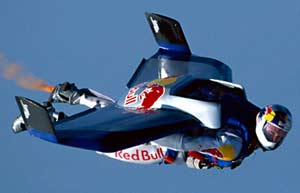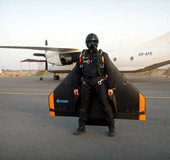The personal flying suit with wings and a rudder is an idea aimed at aviation sports enthusiasts. Military officials, however, see it as a futuristic device that could enable soldiers to fly like bats. At the same time, they fear that terrorists could acquire the secrets of this new weapon to cause harm.
The aircraft is flying at an altitude of 4,000 meters. The engine roars as the plane enters a strong wind area. The tail door of the aircraft drops down. From inside, a figure dressed entirely in black, wearing a black carbon fiber wing suit, leaps out. The force of the wind hits him hard, throwing him off balance momentarily before he regains control. Thanks to the wings, he glides through the air at a speed of 200 kilometers per hour!
The Griffin
 |
| The Skyray flying suit designed by Alban Geissler (Photo: atairaerospace) |
The scene described is not from an action movie or an American comic book. The person jumping out of the plane is not Batman or Agent 007, although the latest James Bond film script considered using a suit just like this one.
The individual in the unique wingsuit is Erich Jetlitko, a former German paratrooper. He, along with a team, is testing a new flying system with wings and a rudder, differing from a conventional aircraft primarily in its compact size.
Three years ago, a similar flying suit gained fame across Europe. In the summer of 2003, Felix Baumgartner used an identical wingsuit to fly across the English Channel. It was named Skyray (Sunray) and was developed for sports by Alban Geissler, a 35-year-old aircraft designer from Munich, Germany. Geissler is now refining it for military use.
The suit currently in testing has been renamed Greif (German for Griffin). Transitioning from recreational use, Greif is evolving into a new military weapon. Geissler is preparing two suits for trials, joined by Jetlitko, who is responsible for developing new equipment for paratroopers at the military logistics company ESG, and Frank Carrecas. This trio is optimistic, as Greif is a collaborative product of Geissler and Jetlitko.
Listen to Jetlitko describe Greif: “If a conventional parachute is a small motorcycle, then Greif is a racing motorcycle.” It allows soldiers to descend to the ground at speeds of up to 220 kilometers per hour, with one hand holding a weapon and the other controlling the rudder. Its superiority over traditional parachutes lies in its ability to remain airborne longer, as it does not rely on free fall.
Once Featured in a James Bond Script
 |
“Batman” Jelitko |
Upon landing, the user must detach the wings from the backpack and deploy the parachute contained within the pack, with the wings still attached via a tether. Jetlitko explains: “You can fly with this wingsuit like flying an aircraft.” To date, a significant drawback remains unsolved: maintaining balance. Even seasoned experts like Jetlitko or Carrecas encounter difficulties. The wingsuit tends to be unstable while airborne. Carrecas even had to make an emergency landing during a test flight. Geissler acknowledges: “We need to refine it so that an average person can operate it without being an expert.”
How will Greif be used in the military? The following scenario has been outlined: A transport plane drops soldiers under the cover of darkness. The soldier, equipped with an oxygen supply system, is dropped from an altitude of about 10 kilometers, far from the target, ensuring safety, as conventional radar cannot detect them. At this altitude, wind currents may be unpredictable, but that poses no problem for flying soldiers. The Greif wings suit adapts to all wind directions. The most significant difference compared to traditional parachutes is that instead of taking 45 minutes to land, it reduces the time to just 15 minutes. Moreover, it allows soldiers to glide at least 40 kilometers.
Geissler currently has another plan: to attach a small jet engine weighing about 15 kilograms to the wingsuit. This addition would enable soldiers to be deployed from lower than 10 kilometers while still ensuring safety, allowing them to fly up to 200 kilometers. Interestingly, an improved Greif wingsuit was included in the script for the film Die Another Day for the character James Bond to use. However, at the last minute, due to actor Pierce Brosnan injuring his knee, the scenes of Agent 007 flying with the Greif wingsuit were canceled.
Fear of Terrorists Using It The idea of incorporating the Greif wingsuit into military applications has drawn significant attention from military officials attending the International Airshow ILA held in Berlin, Germany, last May. If perfected to have stealth capabilities akin to the U.S. B1 stealth bomber, the Greif wingsuit could be revolutionary. Geissler explains: “The Greif wingsuit reflects very weak radar signals due to its shape and internal structure. Only the latest radar systems can detect it.” With such formidable features, Western terrorism experts fear that international terrorist organizations like Al-Qaeda may seek to purchase the Greif wingsuit to execute their most outrageous plots. Therefore, when released on the market, it is essential to implement control measures to prevent suspicious orders. |

















































